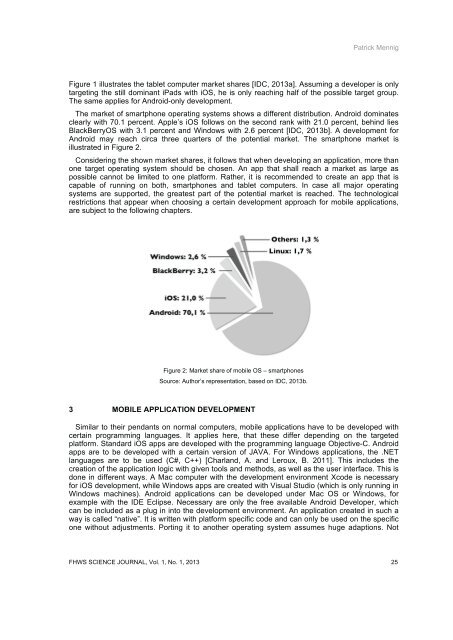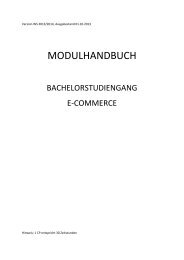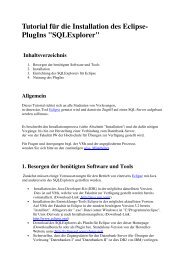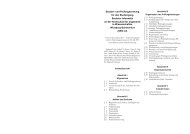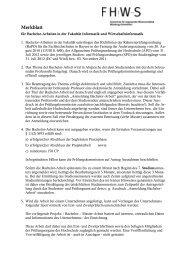FHWS Science Journal - Fakultät Informatik und Wirtschaftsinformatik
FHWS Science Journal - Fakultät Informatik und Wirtschaftsinformatik
FHWS Science Journal - Fakultät Informatik und Wirtschaftsinformatik
Create successful ePaper yourself
Turn your PDF publications into a flip-book with our unique Google optimized e-Paper software.
Patrick Mennig<br />
Figure 1 illustrates the tablet computer market shares [IDC, 2013a]. Assuming a developer is only<br />
targeting the still dominant iPads with iOS, he is only reaching half of the possible target group.<br />
The same applies for Android-only development.<br />
The market of smartphone operating systems shows a different distribution. Android dominates<br />
clearly with 70.1 percent. Apple’s iOS follows on the second rank with 21.0 percent, behind lies<br />
BlackBerryOS with 3.1 percent and Windows with 2.6 percent [IDC, 2013b]. A development for<br />
Android may reach circa three quarters of the potential market. The smartphone market is<br />
illustrated in Figure 2.<br />
Considering the shown market shares, it follows that when developing an application, more than<br />
one target operating system should be chosen. An app that shall reach a market as large as<br />
possible cannot be limited to one platform. Rather, it is recommended to create an app that is<br />
capable of running on both, smartphones and tablet computers. In case all major operating<br />
systems are supported, the greatest part of the potential market is reached. The technological<br />
restrictions that appear when choosing a certain development approach for mobile applications,<br />
are subject to the following chapters.<br />
Figure 2: Market share of mobile OS – smartphones<br />
Source: Author’s representation, based on IDC, 2013b.<br />
3 MOBILE APPLICATION DEVELOPMENT<br />
Similar to their pendants on normal computers, mobile applications have to be developed with<br />
certain programming languages. It applies here, that these differ depending on the targeted<br />
platform. Standard iOS apps are developed with the programming language Objective-C. Android<br />
apps are to be developed with a certain version of JAVA. For Windows applications, the .NET<br />
languages are to be used (C#, C++) [Charland, A. and Leroux, B. 2011]. This includes the<br />
creation of the application logic with given tools and methods, as well as the user interface. This is<br />
done in different ways. A Mac computer with the development environment Xcode is necessary<br />
for iOS development, while Windows apps are created with Visual Studio (which is only running in<br />
Windows machines). Android applications can be developed <strong>und</strong>er Mac OS or Windows, for<br />
example with the IDE Eclipse. Necessary are only the free available Android Developer, which<br />
can be included as a plug in into the development environment. An application created in such a<br />
way is called “native”. It is written with platform specific code and can only be used on the specific<br />
one without adjustments. Porting it to another operating system assumes huge adaptions. Not<br />
<strong>FHWS</strong> SCIENCE JOURNAL, Vol. 1, No. 1, 2013 25


